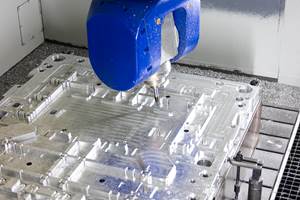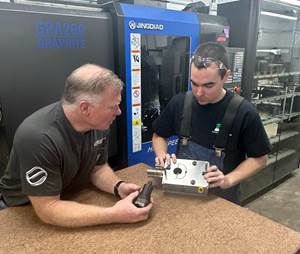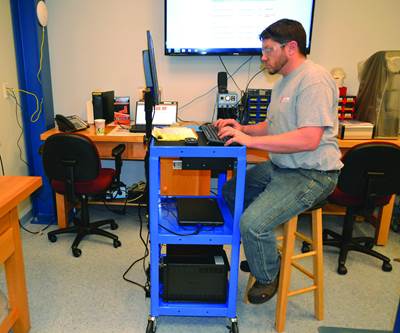Hard Milling Gives Eden Tool a Competitive Advantage
Hard milling proves to be a strategic advantage for a small mold shop that runs lean and serves the medical device market.
Share
What is unique about how Eden Tool Co. applies hard-milling processes to the creation of molds?
Mike Eden, president: The real value of hard milling in the way that we do it is in the consistency that it provides from cavity to cavity, which can be measured in microns rather than in tenths. It delivers major benefits pertaining to mold validation, especially with medical industry customers who make small, complex parts. For example, one of the first molds we built that used 100-percent hard milling was an eight-cavity mold. That mold was designed to make a part that is like a hollow ring, with a diameter of about 2.000 inches. A representative from Beaumont Technologies was undertaking the mold capability studies for my customer at the time that my customer first sampled the mold. Our hard-milling approach really got the attention of the Beaumont Technologies representative because there was less than 1 percent of cavity-to-cavity variation. He told me he would have been satisfied if it was less than 5 percent. It proved to us that hard milling, while not right for every job, was critical for our future success.
After that, we began educating all our customers about the advantages of hard milling, and we began working with them on the front end to make their part designs friendlier for hard milling. Whenever possible, we will use hard milling on 100 percent of a job with no hand work required. Our customers see the advantage of hard milling and look to us for design help for manufacturability. They follow our recommendations for simple geometry changes if the part design allows, so we can implement 100-percent hard milling of a cavity and core when we see fit. Most of the time, we ask for only a slight increase in radii, usually in non-critical areas, to help us use hard milling. It is not a full redesign of our customers’ parts. But, there are some things we just can’t get around, so we might hard-mill about 85 percent of a job and then use EDM on the rest. We will always try to hard-mill the main features of a part to ensure that they are the same from cavity to cavity with very little in dimensional differences. This ensures that we can give customers brand-new, replaceable cavity stacks two years down the road with minimal revalidation required on their end, just by utilizing our systems and processes.
Why do you think your hard-milling process has been a competitive advantage for Eden Tool Co.?
Eden: Offering hard-milling services and understanding the mold validation process and the capability studies have been huge advantages for us over most shops. Lots of people say that they hard-mill, but today the term “hard milling” is totally different than it used to be because it refers to a process and not just milling hardened steel like most people think. Before, I never imagined I would rather cut on a piece of steel with a hardness of 55RC than finish-mill on a piece of P20, but I do. To show how unusual that is, a representative from a cutting tool manufacturer once said to me, “Mike, with my job, I get into a lot of high-end shops across the country. Do you realize that there are probably only five or six companies in the country that use the hard-milling process to the extreme that you do?”
We see a big disconnect with tool shops when they look at part tolerance as compared to CPK’s, especially in the medical market where manufacturers are producing small parts. There is a big difference between the two, and that is huge to the medical people. For example, some people look at a CPK as a regular tolerance, but it is not. Just because that part has a 0.002-inch tolerance does not mean that the whole 0.002-inch tolerance is usable to make the capability study. Some might say, “Well, it’s within tolerance,” but it is not. Everything must balance out, and if one part is at the high end of the tolerance, but the other four parts are at the low end, the capability study is not working—the part will never make CPK. The key is to machine everything that can possibly be machined in the mold so that everything is identical in the way that the plastic is delivered to the part and to the molding area.
Please share an example of a job where hard milling was especially key to a customer’s project.
Eden: Because of its hard-milling expertise, Eden Tool Co. has been involved in several big and successful molding projects throughout the years. One of the most memorable was a project we did for Alcon in which we built all the single-cavity prototypes for a safety handle used on its ClearCut Safety Knives line. We received an award for our work on the project, but when it came to the production tools, they split the molds up between us and another shop. We got our job done quickly. Alcon found that the other shop struggled with their molds. They could not get the required tolerances and make the capability studies. The difference was that they burned everything, and we hard-milled everything. Our mold was more expensive because we laid it out differently and had more parts on it, but we did it so that we could machine everything and have more control over the critical-to-part areas. We wound up getting PO’s for all the production molds. That was a pretty cool feeling.
Are you looking to expand your hard-milling capabilities?
Eden: Currently, we use a Creative Evolution HSD 500 VMC for our hard-milling work. It is a high-speed machining center with a maximum spindle speed of 30,000 rpm. But, it’s not necessarily the machine itself that makes the difference, though it’s important. It’s the process a shop puts around it. It’s also in the control used and how a shop uses it. The control on our Creative machine is fast, and it was first available in the 1990s. It has been only in the past eight to 10 years that some other manufacturers’ controls have caught up to it. It’s that fast.
At Eden Tool Co., we are in the process of evaluating new machining centers by Yasda and Makino. We also are looking at implementing the new laser measuring technology, which we believe would be a huge benefit to our customers because we can provide them with very accurate data measurements for each critical tooling component. Combining this with the proper documentation, we can replicate spare tooling several years down the road without having to fully revalidate the mold, given that the customer’s ISO certification is written that way. Instead, we would only have to validate the mold steel or the components being used, which would save time and money. Additionally, we are looking to get into mold sampling, which we currently outsource.
Related Content
-
True Five-Axis Machine Yields More Throughput, Greater Productivity
CDM Tool & Mfg. Co. LLC increased shop capacity thanks to a versatile high-speed/high-accuracy five-axis Fooke mill capable of cutting very large workpieces quickly and accurately with fewer setups.
-
CT Scanning Helps Micro Molder Reduce Cost of First Article Inspections
CT scanning services performed by 3D ProScan, a division of NyproMold Inc. provides MTD Micro Molding with accurate, high-resolution internal and external measurements performed about seven times faster and at significant cost savings.
-
Five-Axis Graphite Mill With Automation Debottlenecks Electrode Machining
Five-axis electrode cutting enabled Preferred Tool to EDM complex internal screw geometry on an insert that otherwise would have had to be outsourced.
Related Content
True Five-Axis Machine Yields More Throughput, Greater Productivity
CDM Tool & Mfg. Co. LLC increased shop capacity thanks to a versatile high-speed/high-accuracy five-axis Fooke mill capable of cutting very large workpieces quickly and accurately with fewer setups.
Read MoreCT Scanning Helps Micro Molder Reduce Cost of First Article Inspections
CT scanning services performed by 3D ProScan, a division of NyproMold Inc. provides MTD Micro Molding with accurate, high-resolution internal and external measurements performed about seven times faster and at significant cost savings.
Read MoreFive-Axis Graphite Mill With Automation Debottlenecks Electrode Machining
Five-axis electrode cutting enabled Preferred Tool to EDM complex internal screw geometry on an insert that otherwise would have had to be outsourced.
Read MoreHow to Achieve Unmatched Accuracy in Very Large Workpieces
Dynamic Tool Corp. purchases two bridge-style double-column CNCs to increase the cutting envelope and maintain 5-micron cutting accuracy in the long term.
Read MoreRead Next
Maintenance Matters: The Physical Side of Data Entry
A mobile documentation station promotes on-the-fly data entry and usage for mold repair technicians, ingraining documentation into the daily maintenance process.
Read MoreHow to Use Strategic Planning Tools, Data to Manage the Human Side of Business
Q&A with Marion Wells, MMT EAB member and founder of Human Asset Management.
Read MoreHow to Use Continuing Education to Remain Competitive in Moldmaking
Continued training helps moldmakers make tooling decisions and properly use the latest cutting tool to efficiently machine high-quality molds.
Read More








